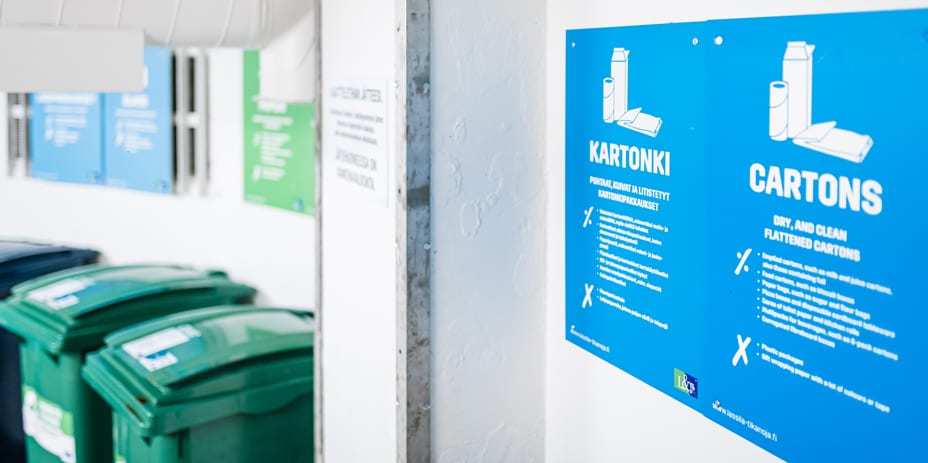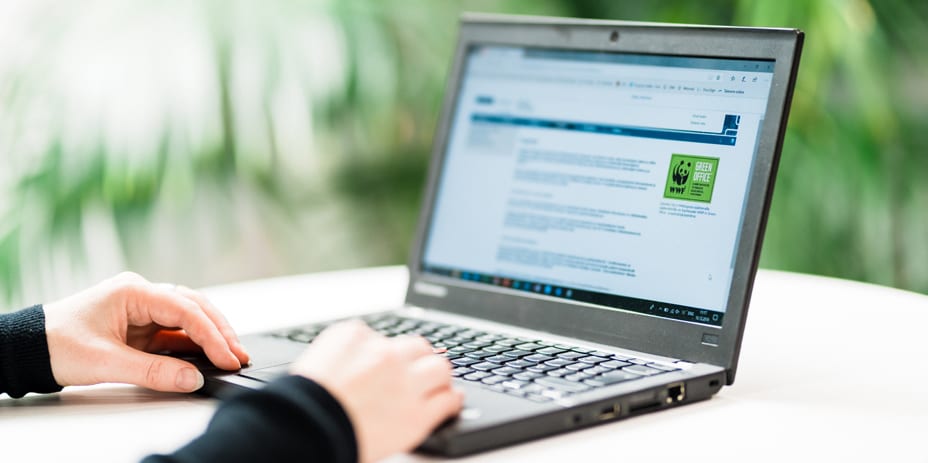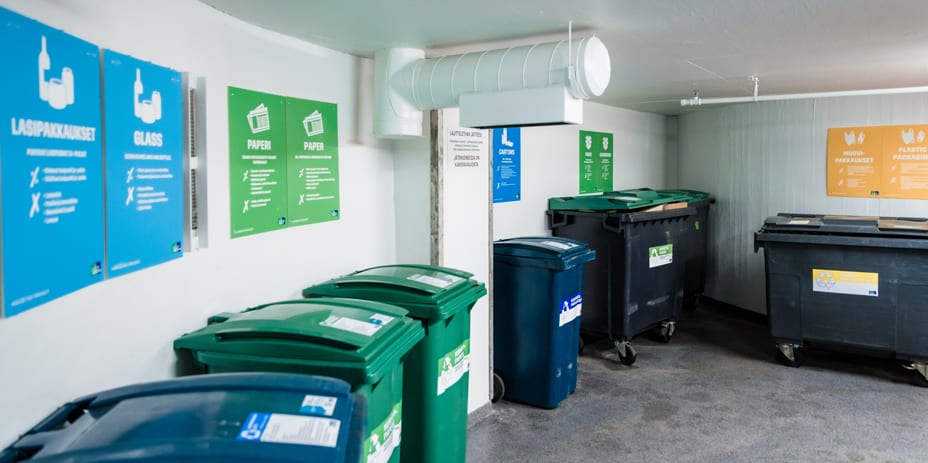
Sponda starts collecting plastic and paperboard with amazing results among tenants
Sponda became the first large property owner to collect post-consumer plastic packaging waste and paperboard at its offices in spring 2019. Up to 80 per cent of the municipal waste collected by tenant companies is recycled.
One of the office buildings participating in the collection is the Dianapuisto property in central Helsinki. The collection of post-consumer plastic packaging and paperboard kicked off with a sorting-related information event for companies, as has been done at Sponda’s other properties in the past.
The sorting of plastic packaging waste and paperboard applies particularly to break rooms.
The event was hosted by an environmental coordinator from Sponda’s partner, who presented the sorting facilities to the companies and gave instructions on how to start recycling.
Volume of plastic waste surprises companies
According to Kimmo Heikkinen, Environmental Coordinator at Lassila & Tikanoja, typical first-stage questions concern the kinds of plastic that are suitable for recycling and how clean the waste should be.


“Often, people are amazed at the volume of plastic waste. Typically, the large energy waste container previously used at an office is replaced with two large containers for paperboard and plastic packaging and a small container for energy waste,” Heikkinen says.
According to Pirkko Airaksinen, Sustainability Manager at Sponda, tenant companies have welcomed the new recycling facilities with open arms.


“Companies are increasingly aware of responsibility issues, and they are looking for ways of influencing climate change and the circular economy. According to our surveys on the responsibility of properties, our customers appreciate well-functioning waste management above all other aspects,” Airaksinen says..
Waste collection to be extended across Finland
Sponda’s aim is to improve the material efficiency of properties by collecting plastic and paperboard waste and, in so doing, minimising the amount of municipal waste that is disposed of by burning. In the big picture, the goal is to create new sustainable practices in the field and promote the circular economy.


“We have managed to increase our recycling rate every year. Last year, it grew by 5 per cent and is now 53 per cent. Our aim is to achieve a recycling rate of 58 per cent at all properties and 67 per cent at shopping centres by 2022,” Airaksinen explains.
The collection of post-consumer plastic packaging and paperboard has started in the Helsinki Metropolitan Area, and the aim is to extend the practice to office properties in other Finnish cities later on.
Involving the entire organisation
At the Dianapuisto property, starting the collection meant learning new habits. Typically, post-consumer plastic packaging and paperboard are sorted in break rooms. At Dianapuisto, the environmental coordinator posted sorting instructions on notice boards and signs on waste bins.
The recycling of plastic packaging has grown exponentially in households and there is similar potential for growth in companies.
“Companies have achieved remarkable results. The company with the highest recycling rate now recycles up to 80 per cent of its previous municipal waste, of which 50 per cent is paperboard and 30 per cent is plastic,” Heikkinen says.


The recycling rate of the property and the carbon footprint of waste management are calculated by adding up all the waste recycled by the companies. Heikkinen explains that analysing the data and comparing different properties are ways of identifying areas of improvement and making the operations more efficient on a larger scale.
“The recycling of post-consumer plastic packaging has grown exponentially in households in the last 12 months, and there is similar potential for growth in companies. It is great that Sponda is leading the way in implementing circular practices also at office properties,” Heikkinen says.
Success through co-operation
According to Heikkinen, the recycling of post-consumer plastic at offices can be extended to cover plastic packaging waste generated in business operations.


“Actually, we are already breaking ground in this field with Sponda. We have promoted the recycling of plastic at shopping centres by improving the sorting of transparent film plastic. The volume of film plastic collected at Sponda’s properties more than doubled from the previous year in 2019.”
Increasing the recycling rate and adopting new practices requires co-operation between several parties. Heikkinen also emphasises the importance of communication.


“Everyone — tenants, the cleaning company, property management and waste management—must receive the right information in order to ensure efficient sorting. Furthermore, tenants and employees change often at offices and shopping centres, which means that instructions must be provided continuously.”
Sponda creates new practices in the field
- What? Sponda started sorting post-consumer plastic and paperboard packaging at office properties in the Helsinki Metropolitan Area in spring 2019. Break rooms are a particular focus area. For example, the majority of lunch packaging can be recycled as plastic or paperboard waste.
- Why? The aim is to promote recycling and reduce the amount of waste disposed of by burning and help the tenants implement responsible practices. The collected plastic will be recycled as raw material for the plastic industry.
- What’s next? Sponda wants to create new sustainable practices in the field and promote the circular economy. The next step is to extend the collection to all office properties in Finland and develop the recycling further.
- What is the volume? Approximately 35,000 people work in Sponda’s office properties every day, and its shopping centres have approximately 95,000 customers.
